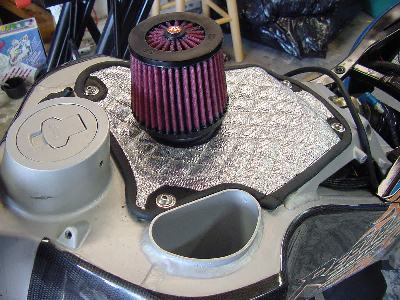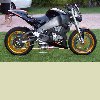| Author |
Message |
    
Glitch

| | Posted on Friday, December 10, 2004 - 01:43 pm: | 




|
I could be wrong, because I honestly don't know, but...
I was talking to a Harley mechanic the other day, and he said the DDFI system we use, uses the air temp sensor to let the computer know when to add fuel to help cool things off, and not ping. Running a bit rich helps cool the heads, and stops ping. If this is true, it makes sense to me. It also kind of explains why the XBs don't have a VOES.
Or am I way off here? |
    
Ingemar

| | Posted on Friday, December 10, 2004 - 02:38 pm: | 




|
The documentation I have read has never mentioned such a thing.
Would this be with a stock ecm, race ecm or both? |
    
Fullpower

| | Posted on Friday, December 10, 2004 - 02:50 pm: | 




|
With the 12 airbox and race filter, hp and torque are essentially the same as with the FAST intake. dyno results not posted. anybody else have proof that a small filter can out flow a filter with 3 times the surface area? still waiting.}}} |
    
Firebolt020283

| | Posted on Friday, December 10, 2004 - 03:31 pm: | 




|
fullpower did u forget about enlishmans test and it proved that the fast system was better |
    
Black9
| | Posted on Friday, December 10, 2004 - 06:14 pm: | 




|
The only difference between the 9 & 12 air box is the dimple in the top of the 12 box, it's still enclosed...the 12 doesn't flow more air till you open it up ie. "swiss cheese it", or eliminate it all together.Cutting the box open on a 12 DOES make a difference, as would a totally open element. |
    
Metalstorm

| | Posted on Friday, December 10, 2004 - 10:29 pm: | 




|
This is just a guess but something tells me that a small K&N and a larger K&N would have the same flow rate cause air goes through the cotton at the same speed regardless of size. It's the volume of the airbox that would make the difference I suppose. Anouther guess here; a different sized throat on the injector would most definitely change the flow rate cause no matter how big a filter or airbox you have, you can only stuff so much down the throat opening at a time.
I dunno, like I said I'm just guessing. I just thought I'd put out there for ppl to ponder. |
    
Hkwan
| | Posted on Saturday, December 11, 2004 - 12:14 am: | 




|
Metalstorm, I think you would be accurate on the flow rate vs. size of K&N as long the filter is clean. The larger filter would / should be able to have a less frequent cleaning interval. |
    
Metalstorm

| | Posted on Sunday, December 12, 2004 - 12:39 am: | 




|
Hmmm... I never thought about that. I'll admit after thinking about it that that makes perfect sense. |
    
Briz31
| | Posted on Sunday, December 12, 2004 - 11:47 pm: | 




|
http://www.ramraceco.com/spareFASTreport.html
Velocity Stack Challenge - FAST System By Hillbilly-Motors Test Report
Equipment Name: F.A.S.T. System
Vendor: Hillbilly Motors
Contact: Jens
Address: Bleialferstr. 13 54597 Auw /Germany
Tele: 0049-6552-929046
Email: info@hillbilly-motors.com
Web site: www.hillbilly-motors.com
US Distributor: Iron Machine Inc
Tele: 707 786 4736
Email: cory@ironmachine.com
Web site: www.ironmachine.com
Introduction
The FAST System comprises 3 parts;
a) A specifically shaped heat shield,
b) An aluminum velocity stack that extends the throttle body inlet
c) A large K&N air cleaner plus securing clip.
The Hillybilly FAST system is unique in these tests in that it requires the complete removal of the stock inner air box. The heat shield fits to the frame where the air box mounts. The supplied velocity stack is used to extend the throttle body above the heat shield and then acts as the mount for the large K&N air filter.
Test bike: Buell XB9R (03 model) - Stock motor (just less than 1700 miles), Wileyco exhaust muffler (Basically straight through), Stock Induction system (Removed for this system), Buell Race ECM.
Theory of Operation
Jens at Hillbilly went to great lengths to explain how the FAST System came into being. Based on Hillybilly’s experience with the previous generation of Buells, they found that flowing heads was only part of the issue of getting the motor to breath easier. Getting enough air into the motor was another problem. When Hillbilly set about getting more out of an XB, they created the complete induction system on a flow rig suspecting the XB had similar air flow/demands to the previous models. They were able to determine that the stock XB air box/filter arrangement was a bottleneck restricting the air the motor needed (Twins have a large appetite for air). They then set about de-restricting the air induction equipment. The FAST System is the result.
Fitting
The fit and quality of the parts are good, especially the heat shield or blanket, fitting the frame area perfectly. The stock rubber velocity stack and the complete inner air box are discarded.
The two crank case vents and the induction air temperature sensor that are installed to the inner air box lower, need to be removed and repositioned. The temperature sensor must be carefully removed from the air box and is the positioned under the heat shield between the 2 cylinders, held in place with a couple of zip or cable ties. The crankcase vents for the sake of this test were simply routed away from the air box area and allowed them to breath to atmosphere. Never block these pipes or you can pressurize your motor with potentially nasty results.
Results - At the Dyno
I’m deliberately avoiding giving final HP/Torque values in this report. The reason for this is that there are many variances that can effect overall dyno results. To start with, everyone’s bike has different output characteristics as a function of build tolerances, wear and so on. Temperature, pressure, humidity and even the dyno itself all impact the final numbers. The important thing is the change in the relative performance values between the systems compared to the baseline stock set-up on the same dyno.
Although I have a basic understanding of German, I could not find any vendor claims for the system. This is likely due to European advertising law.
Looking for repeatability from the test method, my test criteria desired that the bike make 5 back-to-back dyno runs with less than 0.5 HP variation between all 5 runs if possible over the rpm range 3000 to rev limiter. The FAST system satisfied these criteria in 5 straight dyno pulls. The FAST System gave a 6.0 HP peek increase. This began as +3 HP at 3000 rpm to +6 HP at 7000 rpm. From 7000 to the rev limiter there is a discernable tail off in the power characteristic although the power is still rising, just not as quickly as before. The midrange hole is reduced considerably to a flat spot (Between 5500 to 6000 rpm) in the torque before the power kicks in from just under 6000 rpm.
The Ride Experience
What can you say about a 6HP increase (about 9% increase over stock), you notice it!! I have ridden the FAST system at 2 race meetings at different tracks and have found that my gear change and brake point markers had all moved. This is the confirmation to a racer that something tangible has changed. I was getting into corners significantly faster than previously experienced. From 6000 to 7000 rpm especially, the bike pulls like a freight train. There is a significant increase in the induction noise at least in the riders ears. At idle and low rpm’s it sounds like….well just odd. At rpm’s above 6000 the motor sings as you can almost discern each breath of air that is being sucked in.
Afterthoughts
The FAST system has proved a couple of theories to me that have been bounced around the various Buell bulletin boards almost since the bikes introduction.
1) People have been putting holes in the inner air box to get more air to the motor – The FAST system is the ultimate in air box minimization and very effective!!
2) Other vendors offer methods to get cool air to the motor – The FAST system achieves this as well via the heat shield or blanket.
In my opinion, if you quest is for maximizing the HP gain and you regularly ride at high rpm’s, then this may be the system for you.
The Hillbilly FAST was the winner of the RamRaceCoi Velocity Stack Challange. We will be retaining the FAST system for further development of our race XB9. This may be with alternative external air intakes directly on the outer air box cover and possibly with conditioning type velocity stacks. In accordance with the rules of the Challange, Hillbilly Motors are now a RamRaceCo Sponsor - Welcome onboard.
Hillbilly Motors.
www.hillbilly-motors.com
Comments from Hillbilly Motors
First of all let us thank Mark that he took these work, and the discussion with the “non believers” Full. Air. Supply. Technology. F.A.S.T. -the name is the program -feed the Beast ! In cooperation with M-TeK Engineering we developed that System with the understanding of the needs after hundreds of Flow Bench and Dynotest Hours. We are very happy to get that confirmation of or work.
ve Fun! Jens |
    
Briz31
| | Posted on Monday, December 13, 2004 - 01:01 am: | 




|
FAST System, (to follow up my previous post)
much has been said with regards to these systems, I found these tests on all the systems available at:
http://www.ramraceco.com
Have a read guys, it's quite interesting...
Regards
Briz31
(Buell XB9s rider in Australia) |
    
Firebolt020283

| | Posted on Monday, December 13, 2004 - 09:30 am: | 




|
briz englishman posted this test when he first doen it, that is his web site you got that info from if u look in the knowlage vault there is the rest of the test on there. Alot of us older guys have already read the test (even though i dont thing im an old badwebber). |
    
Trenchtractor

| | Posted on Tuesday, December 14, 2004 - 06:39 pm: | 




|
OK, I've looked into a mob called Green Cotton Filters... They are european, make filters for european cars, anyway.
They do pod filters too, one about the same size and design as the K&N used in the FAST system was s'posed to be good for up to 120hp or there abouts (IIRC). I think that's plenty for the 'average' XB.
Next point, from all the research I've done, it's not the extra air flow that yeilds better performance by swiss cheesing the air box, but it's the greater effective air box volume... So Metalstorm was thinking in the right direction, I think.
To back this up, a while ago I calculated the cross sectional area of the intake tube through the frame, it was 90 or 100mm or there abouts... Now you've got a 49mm throttle body, so there is plenty of air flow there...
As for velocity stacks, as far as I can tell they are going to influence you power/torque curves just like a muffler would. So there would be no point using a v stack that gives great top end and a muffler aimed at the bottom end... Or would there?? |
    
M1combat

| | Posted on Tuesday, December 14, 2004 - 06:49 pm: | 




|
You need to remember that air is a compressible gas. The REAL design goal of an intake and exhaust tract is to have the proper pressure waves. Flow is important, but it's easy to have more than you need. Proper length is the most important design factor from what I've learned.
I think that for those of us who have swapped exhausts on 12s... using the exhaust valve actuator to make a variable length intake tract would be a good investment of time. The cable would need to be cammed properly to achieve the desired results, and that would take a LOT of trial and error (unless of course, if you a wiz with the proper math principals  ). ). |
|